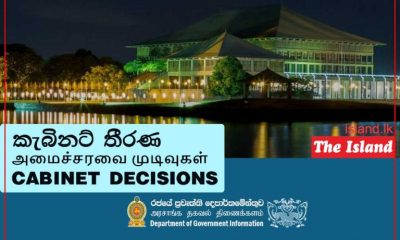Features
International recording stars, global icons…in our scene!

 Quite a few of our local artistes describe themselves as international recording stars…and global icons!
Quite a few of our local artistes describe themselves as international recording stars…and global icons!
Of course, we would love to have such performers in our midst, but, unfortunately, none of these artistes come into either of the categories – International Recording Stars, or Global Icons.
According to informed sources, International Recording Artistes are individuals who have gained recognition, and acclaim, for their singing talents, and contributions to the music scene, on a global scale, with world-wide chart hits, etc.
The difference is that artistes who are recognised by their country are National artistes, while International artistes are recognised globally…the whole world.
As for Global Icons, the rise of K-Pop has been phenomenal, with groups like BTS, BLACKPINK, and EXO dominating the charts and breaking records, worldwide.

Tanvi Shah: First Indian woman to win a Grammy Award
Their catchy tunes, intricate choreography, and strong social media presence have propelled them to global superstardom, setting new trends in the music industry.
I would also classify Olivia Rodrigo and Taylor Swift as present day Global Icons. Of course, there are many more.
Olivia Rodrigo has already cemented herself as one of the hottest new music icons of the twenties because of her chart-topping album ‘Sour’ with smash hits ‘Good for You’ and ‘Driver’s License’, emerging as global chartbusters.
Taylor Swift has been a music icon since the early 2000s and dropped some of the biggest albums of the millennium, but the twenties may still be her most significant decade yet as she has re-recorded and released Taylor’s Version of many of her hit songs and records and they have turned out to be chart-topping hits – world-wide.
Where local artistes are concerned, some of them are being hyped up way beyond their capabilities and these performers just keep blowing their own trumpet, at every given opportunity, with hardly anything new to offer the international scene.
In today’s ever-evolving music industry, the influence of foreign music cannot be overlooked but have any of our artistes been able to do the needful with their music – capture the international music scene, on a global scale…and I mean a global scale.
Except for bassist Hussain Jiffry, playing bass for Herb Alpert and wife Lani Hall’s quintet, who took home a Grammy, when the group won the Best Pop Instrumental Album Award in 2014, we have absolutely nothing to our credit,

Hussain Jiffry: Grammy Award in 2014
The Indians have won several Grammys, with fusion band Shakti winning Best Global Music Album at the 2024 Grammy Awards in Los Angeles
Tanvi Shah, Indian’s first woman to win a Grammy Award (for her performance in the song ‘Jai Ho’ from the movie ‘Slumdog Millionaire’), was seen in action at the Dubai International Stadium, early this year, and cricket enthusiasts and music aficionados witnessed a unique collaboration between two subcontinent legends and a talented musician.
Cricketers Danny Morrison and Wasim Akram, along with Tanvi Shah, created a dynamic trio that blended the sport of cricket with the brilliance of music.
What a day it will be if ever we win a Grammy or have one of our artistes top the charts in the scene that matters – UK Top 10, Billboard Top 10, or World Singles Chart.
Features
Sri Lankan scene a boon to Roger Menezes

 Although based in Australia, Sri Lankan-born Roger Menezes finds the Sri Lankan scene, as a performer, irresistible.
Although based in Australia, Sri Lankan-born Roger Menezes finds the Sri Lankan scene, as a performer, irresistible.
Over the past couple of years he has been here many times; his last visit was in February this year…and he is back again.
Recollecting his last trip to Sri Lanka, Roger said he left for Australia on 15th February, just after his Valentine’s Day performance, on 14th February.
“Yes, my final gig was at the Broadway Pub, in Dehiwela, which was a sell out a week before the event. My music that night was mainly the hits and memories of the good times where there was fun laughter dancing and good music, and the audience loved it.”
Roger will be doing the Broadway Pub scene again, and he will be seen in action this Friday, 02nd May.
His month’s stay in Sri Lanka will include performances at the Kingsbury, down south in Kalutara, at the Tangerine and The Royal Palms, a Friday night and a Sunday Brunch at the Capri, with probable dates at the Mahaweli Reach, Kandy, for Mother’s Day lunch and dinner, and Oak Ray Hotels.

Roger (with The Jetliners) at the Taj Hotel Bombay (now Mumbai) in 1970
Roger also mentioned that Kandy Myst by Cinnamon may be included in his work schedule before he departs for Australia, adding that he also wants to do some charity shows at St. Nikolaas Homes, run by the DBU, at Dehiwela, and a show at Ward Place for the School for Children with Special needs.
“You give back or share your music on your own accord. It’s nice to give back …very rewarding, indeed.”
During his stay in Sri Lanka, Roger says he would love to take a break from music and get away somewhere serene and beautiful for a couple of days.
He also indicated that he has many dates to confirm, with major tourism hotels, when he returns, in July, for the second leg of his tour.
Roger came into the spotlight performing at the Galadari Hotel.
“A big thank you to Sampath Siriwardena, and the Management of the Galadari, for accommodating me. This was my stepping stone and I humbly say this I am waiting to go back home to the Galadari / Raddison Blue to continue my journey.”
Roger’s rise to fame, in the scene here, has been quite exciting and he now has lots of fans who appreciate his music and wait impatiently for his return…from Down Under.
Features
Inner Vision … in action this Friday

Yes, it has certainly come as a surprise to bassist Benjy Ranabahu when his new band, Inner Vision – just a few weeks old – is already being sought after.
His original plan was to take on the local showbiz scene towards the end of May, or early June, but music lovers thought otherwise; they wanted immediate action and Benjy is ready to do the needful.
This Friday, 02nd May, Inner Vision will light up the scene at the famous The Irish Pub, in Colombo.
It will be action from 8.00 pm to 12 midnight and Benjy says they are going to make it a happening scene for those who turn up at The Irish Pub this Friday.
In the meanwhile, Inner Vision has secured the services of Sanjeewa Uyanahewa to handle the keyboards, and the rest of the members are Upali Fernando (lead guitar), Lelum Ratnayake (drums), Viraj Cooray (guitar), Nish Peiris (female vocalist) and the dynamic Benjy doing the needful on bass.
The plus factor is that with the exception of Benjy, the others are also known for their singing capabilities.
In fact, last week’s exclusive article about Inner Vision, in
The Island (22nd April), generated a lot of interest among music lovers and several well-known local performers.
The famous Rukshan Perera had this to say:
“Many familiar faces with lots of talent. Wishing Benjy, and Inner Vision all the very best.”
Features
Trump tariffs and their effect on world trade and economy with particular reference to Sri Lanka

In the early hours of April 2, 2025, President Donald Trump stood before a crowd of supporters and declared it “Liberation Day” for American workers and manufacturers. He signed an order imposing a minimum 10% tariff on all US imports, with significantly higher rates, ranging from 11% to 50%, on goods from 57 specific countries. This dramatic policy shift sent immediate shockwaves through global markets and trade networks, marking a profound escalation of the protectionist agenda that has defined Trump’s economic philosophy since the 1980s.
The implications of these tariffs extend far beyond America’s borders, rippling through the intricate web of global trade relationships that have been carefully constructed over decades of economic integration. While Trump frames these measures as necessary corrections to trade imbalances and vital protections for American industry, the truth is, it’s way more complicated than that. These tariffs aren’t just minor tweaks to trade rules, they could totally upend the way global trade works in the global economic order, disruptions that will be felt most acutely by developing economies that have built their growth strategies around export-oriented industries.
Among these vulnerable economies stands Sri Lanka, still recovering from a devastating economic crisis that led to sovereign default in 2022. With the United States serving as Sri Lanka’s largest export destination, accounting for 23% of its total exports and a whopping 38% of Sri Lanka’s key textile and apparel exports, the sudden imposition of a 44% tariff rate threatens to undermine the country’s fragile economic recovery. Approximately 350,000 Sri Lankan workers are directly employed in the textile industry. These tariffs aren’t some far-off policy, they are an immediate threat to their livelihoods and economic security.
The story of Trump’s tariffs and their impact on Sri Lanka offers a compelling window into the broader tensions and power imbalances that characterise the global trading system. It illustrates how decisions made in Washington can dramatically alter economic trajectories in distant corners of the world, often with little consideration for the human consequences. It also raises profound questions about the sustainability of development models predicated on export dependency and the adequacy of international financial institutions’ approaches to debt sustainability in developing economies.
This article examines the multifaceted implications of Trump’s tariff policies, tracing their evolution from his first administration through to the present day and analysing their projected impacts on global trade flows and economic growth. It then narrows its focus to Sri Lanka, exploring how the country’s unique economic circumstances and trade profile make it particularly vulnerable to these tariff shocks.
Finally, it considers potential mitigation strategies and policy responses that might help Sri Lanka navigate these turbulent waters, offering recommendations for both immediate crisis management and longer-term structural adaptation.
As we embark on this analysis, it is worth remembering that behind the economic statistics and trade figures lie real human lives and communities whose futures hang in the balance. The story of Trump’s tariffs is ultimately not just about trade policy or economic theory but about the distribution of opportunity and hardship in our interconnected global economy.
TRUMP’S TARIFF POLICIES: PAST AND PRESENT
Historical Context of Trump’s Protectionist Views
Donald Trump’s embrace of protectionist trade policies did not begin with his presidency. Since the 1980s, Trump has consistently advocated for import tariffs as a tool to regulate trade and retaliate against foreign nations that he believes have taken advantage of the United States. His economic worldview was shaped during a period when Japan’s rising economic power was perceived as a threat to American manufacturing dominance. In interviews from that era, Trump frequently criticised Japan for “taking advantage” of the United States through what he characterised as unfair trade practices.
This perspective has remained remarkably consistent throughout his business career and into his political life. Trump views international trade not as a mutually beneficial exchange but as a zero-sum competition where one country’s gain must come at another’s expense. This framework fundamentally shapes his approach to tariffs, which he sees not as taxes ultimately paid by American consumers and businesses (as most economists argue) but as penalties paid by foreign countries for their supposed transgressions against American economic interests.
First Term (2017-2021) Tariff Policies
When President Trump took office in January 2017, he quickly began implementing the protectionist agenda he had promised during his campaign. His administration withdrew from the Trans-Pacific Partnership on his third day in office, signalling a dramatic shift away from the multilateral trade liberalisation that had characterised American policy for decades.
The first major tariffs came in January 2018, when Trump imposed duties of 30-50% on imported solar panels and washing machines. While significant, these were merely the opening salvos in what would become a much broader trade offensive. In March 2018, citing national security concerns under Section 232 of the Trade Expansion Act, Trump announced tariffs of 25% on steel and 10% on aluminium imports from most countries. These tariffs initially exempted several allies, including Canada, Mexico, and the European Union, but by June 2018, these exemptions were revoked, straining relationships with America’s closest trading partners.
The most consequential trade action of Trump’s first term, however, was the escalating tariff war with China. Beginning in July 2018, the administration imposed a series of tariffs on Chinese goods, eventually covering approximately $370 billion worth of imports. These measures were justified under Section 301 of the Trade Act, based on allegations of intellectual property theft and forced technology transfer. China responded with retaliatory tariffs on American exports, particularly targeting agricultural products from politically sensitive regions.
By the end of President Trump’s first term, the average US tariff rate had risen from 1.6% to approximately 13.8% on Chinese imports and 3% overall, the highest level of protection since the 1930s. While a “Phase One” trade deal with China in January 2020 paused further escalation, most of the tariffs remained in place, becoming a persistent feature of the international trading landscape.
Current Tariff Policies (2024-2025)
President Trump’s return to the White House in 2025 has brought an even more aggressive approach to tariffs. During his campaign, he promised tariffs of 60% on all Chinese imports, 100% on Mexico, and at least 20% on all other countries. While the actual implementation has not precisely matched these campaign pledges, the scale and scope of the new tariffs have nevertheless been unprecedented in modern American trade policy.
The centrepiece of Trump’s current trade policy was announced on April 2, 2025, dubbed “Liberation Day” by the administration. The executive order imposed a minimum 10% tariff on all US imports, effective April 5, with significantly higher tariffs on imports from 57 specific countries scheduled to take effect on April 9. These country-specific tariffs range from 11% to 50%, with China facing the highest rate at 145% or rather 245%, effectively cutting off most trade between the world’s two largest economies.
The formula for determining these “reciprocal tariffs” remains somewhat opaque, but appears to be based primarily on bilateral trade deficits, with countries running larger surpluses with the United States facing higher tariff rates. This approach reflects Trump’s persistent view that trade deficits represent “losing” in international commerce, a perspective at odds with mainstream economic thinking, which generally views trade balances as the result of broader macroeconomic factors rather than evidence of unfair trade practices.
For Sri Lanka, the formula resulted in a punishing 44% tariff rate, the sixth highest among all targeted countries. This places Sri Lankan exports at a severe competitive disadvantage in the American market, threatening an industry that has been central to the country’s economic development strategy for decades.
The stated objectives of these tariffs include reducing the US trade deficit, revitalising American manufacturing, punishing countries perceived as engaging in unfair trade practices, and generating revenue that Trump has variously suggested could fund infrastructure, childcare subsidies, or even replace income taxes entirely. However, economic analyses from institutions like the World Trade Organisation, the Penn Wharton Budget Model, and numerous independent economists suggest these objectives are unlikely to be achieved, and that the tariffs will instead reduce economic growth both domestically and globally while raising prices for American consumers.
After a violent reaction in financial markets, the administration announced a 90-day pause on the higher country-specific tariffs for all nations, except China. However, the baseline 10% tariff remains in effect, and the threat of the higher tariffs continues to create significant uncertainty in global markets. This uncertainty itself acts as a drag on economic activity, as businesses delay investment decisions and reconsider supply chain arrangements in anticipation of potential future trade disruptions.
GLOBAL ECONOMIC IMPACT OF TRUMP TARIFFS
The imposition of sweeping tariffs by the Trump administration has sent ripples throughout the global economy, with international organisations, economic research institutions, and financial markets all signalling significant concerns about their far-reaching consequences. What began as a unilateral policy decision by the United States threatens to fundamentally alter global trade patterns, disrupt supply chains, and potentially trigger a broader economic slowdown that could affect billions of people worldwide.
WTO Projections on Global Trade Contraction
The World Trade Organisation (WTO), the primary international body overseeing global trade rules, has issued stark warnings about the impact of Trump’s tariffs. In its latest assessment of the global trading system, the WTO dramatically revised its trade growth projections for 2025. Prior to the tariff announcements, the organisation had forecast a healthy 2.7% expansion in global trade for the year. Following Trump’s “Liberation Day” declaration, it now projects a 0.2% contraction, a negative swing of nearly three percentage points.
This contraction in trade is expected to have direct consequences for global economic growth as well. The WTO has downgraded its global GDP growth forecast from 2.8% to a more anaemic 2.2%. While this may seem like a modest reduction, in absolute terms, it represents hundreds of billions of dollars in lost economic activity and potentially millions of foregone jobs worldwide.
Of particular concern to the WTO is the potential “decoupling” of the world’s two largest economies. Ngozi Okonjo-Iweala, the WTO’s director general, has expressed specific alarm about this phenomenon, noting that trade between the United States and China is expected to plunge by 81-91% without exemptions for tech products, such as smartphones. Such a dramatic reduction in bilateral trade between these economic giants would be “tantamount to a decoupling of the two economies” with “far-reaching consequences” for global prosperity and stability.
The WTO has also modelled more severe scenarios that could materialise if the currently paused “reciprocal tariffs” are reimposed after their 90-day hiatus. In such a case, the organisation projects a steeper 0.8% decline in global goods trade. Should this be accompanied by a surge in “trade policy uncertainty” worldwide, as other countries adjust their own policies in response, the WTO suggests an even more severe 1.5% contraction in trade could occur, with global GDP growth potentially falling to just 1.7%, a level that would place many countries perilously close to recession.
by Ali Sabry
(To be continued)
-

 News7 days ago
News7 days agoOrders under the provisions of the Prevention of Corruptions Act No. 9 of 2023 for concurrence of parliament
-

 Features7 days ago
Features7 days agoRuGoesWild: Taking science into the wild — and into the hearts of Sri Lankans
-

 Business2 days ago
Business2 days agoPick My Pet wins Best Pet Boarding and Grooming Facilitator award
-

 News6 days ago
News6 days agoProf. Rambukwella passes away
-

 Opinion7 days ago
Opinion7 days agoSri Lanka’s Foreign Policy amid Geopolitical Transformations: 1990-2024 – Part IX
-

 News2 days ago
News2 days agoNew Lankan HC to Australia assumes duties
-

 Features2 days ago
Features2 days agoKing Donald and the executive presidency
-

 Business2 days ago
Business2 days agoACHE Honoured as best institute for American-standard education












